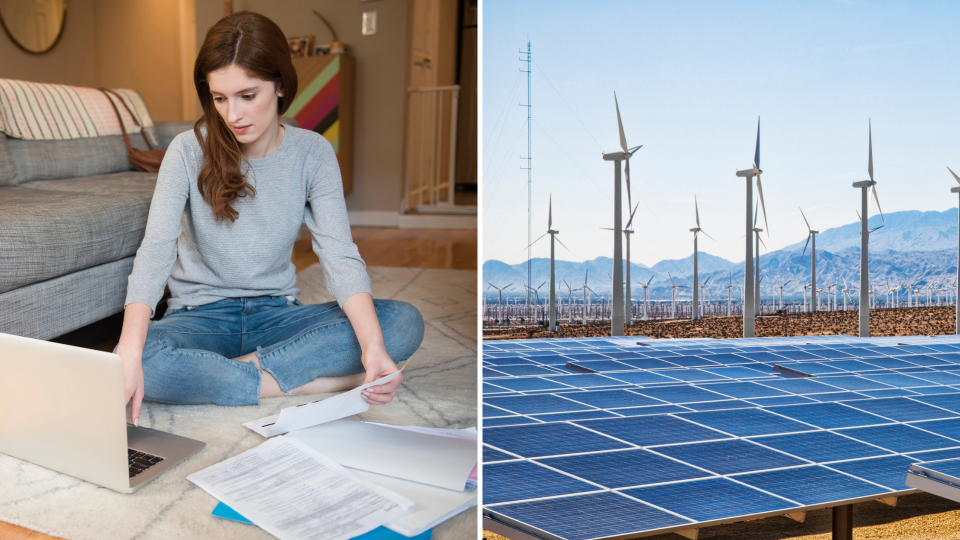Your power bill will change in the next two years depending on where you live. Here’s what it means for you

Power prices across Australia will fall by 2.1 per cent over the next two years, new figures from the Australian Energy Market Commission (AEMC) reveal.
Most Aussies will enjoy cheaper energy bills over the financial years of 2019-2021 thanks to a “structural change” in the wholesale energy sector that will see more renewable sources of power, particularly from wind and solar.
“Demand is relatively flat so wholesale costs are being driven lower by increased supply from renewables,” the AEMC explained.
Generally speaking, Aussies can expect to pay around $28 less in electricity in July 2020 than they are today, with the national power bill to fall by $29 from $1367 to $1338.
But how much you’ll save depends on where you live.
How much will I save?
It varies state to state: NSW, Victoria, South Australia and Queensland will see prices fall.
But Northern Territorians, Western Australians and Tasmanian won’t be so lucky, and will actually be pay more for electricity over the next two years.
“Prices across Australia are likely to be down in states which have competitive markets, but there are regional supply chain factors that will affect price outcomes in the jurisdictions depending on where you live and how much electricity you use,” said AEMC chief executive Anne Pearson.
NSW
NSW residents will see a modest drop of 2.1 per cent in power prices in the next two years. That comes to $27 in total.
The NSW government recently released free energy comparison website Energy Switch to help residents keep a bit more money in their pocket.
Victoria
Power prices in Victoria will fall by 2.3 per cent in the next two years.
“Over the next 2 years (from Jan 2019 to Jan 2021) Victorian households are likely to save around $12.50 a year – $25 in total – on their electricity bills as wholesale costs continue to fall,” said the AEMC.
ACT
People living in the Bush Capital will unfortunately be forking out slightly more for electricity due to “rising environmental scheme costs and network costs”.
ACT residents will be paying approximately $87 more in total in July 2020 than they are today.
South east Queensland
South east Queenslanders will enjoy $152 back in their wallets over the next two years thanks to a 2.8 per cent drop in power prices.
This state will see a rise in renewable generation capacity.
Western Australia
The WA government will have the final say on power prices, but AEMC estimates that power prices in this state will rise by 4.5 per cent, with residents paying $155 more in two years’ time.
Prices are being pushed up by rising wholesale at network costs.
“Residential electricity prices paid by consumers are set by the Western Australian Government and may not reflect the underlying costs of supplying electricity,” the AEMC said.
South Australia
South Australians can expect to pay $120 less for electricity between 2019 to 2020, representing a fall of 6.5 per cent.
Falling wholesale costs, increasing renewable energy capacity and flat environmental costs will contribute to the drop.
Tasmania
Tasmanians will save $39 across 2019 and 2020, a modest price drop of 1 per cent.
The Tasmanian government has a capped the state’s retail electricity prices to 2.05 per cent from 2017-18 to 2018-19.
Northern Territory
Northern Territory residents can expect to pay 2.7 per cent, or $47 more across two years, which AEMC says is “in line with the price path set by the Northern Territory Government”.
“Over the next two years … the price trend is primarily driven by environmental costs and an average annual increase of 1.3 per cent in wholesale costs with no change in network costs.”
Make your money work with Yahoo Finance’s daily newsletter. Sign up here and stay on top of the latest money, news and tech news.
Read next: Why the NSW government is giving some households $1k this Christmas
Read next: The free tool Aussies are using to save $1,600 on their energy bills
Read next: High energy bills will cost the Aussie economy $8.5 billion: here’s why
Read next: Australia ranks atrociously in climate change action

 Yahoo Finance
Yahoo Finance 
